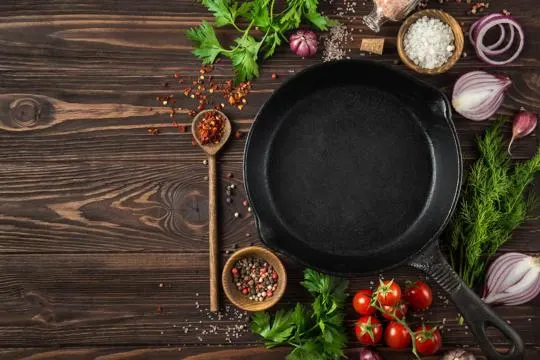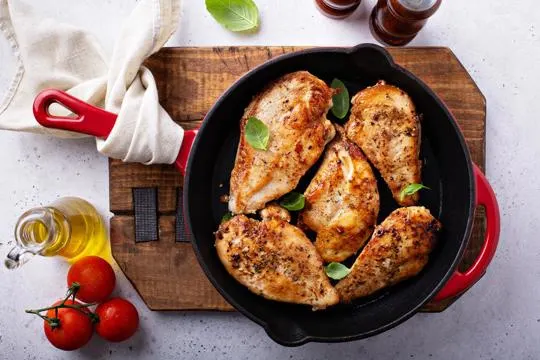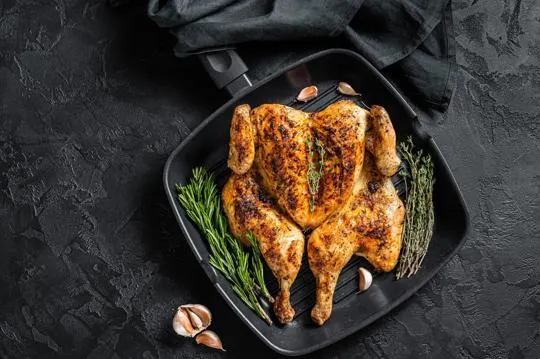Summary of key points
The main difference between a grill pan and a skillet is in their surface. A grill pan has raised ridges, mimicking the appearance of outdoor grilling, while a skillet has a flat surface.
In terms of functionality, a grill pan is best for cooking items that need to sear or have visible grill marks, such as meats and vegetables. A skillet can be used for a variety of cooking techniques, including sautéing, frying, and simmering.
In terms of maintenance, a grill pan may require more cleaning due to its ridges, while a skillet can be easier to clean and maintain.
Both cookware options have their own unique benefits and are essential tools in any kitchen.
In the kitchen, two titans stand out: the grill pan and the skillet. Both have their fans and their unique uses. The big question: what sets them apart?
We’ve all been there, staring at our kitchenware, pondering which to use. The grill pan boasts ridges for those perfect char lines on your food. The skillet offers a smooth, flat surface ideal for frying and sautéing.
We once ruined a perfect steak by picking the wrong one. Lesson learned.
Skillets are versatile, a go-to for many chefs. Grill pans, on the other hand, specialize in simulating outdoor grilling. They’re like the indoor barbecue we never knew we needed.
The choice might seem trivial, yet it can transform your cooking. Know your pans, know your meals.
What is a Grill Pan?

A grill pan is a kitchen essential for creating that outdoor-grilled flavor indoors.
It has ridges which create grill marks and allow fat to drain away.
This makes it healthier than a traditional frying pan.
Materials such as cast iron, stainless steel, or aluminum can be used to make a grill pan.
Cast iron pans are best known for distributing heat evenly and retaining it.
Stainless steel and aluminum are lighter and easier to handle.
Grill pans can sear food, creating tasty marks plus texture and flavor.
High temperatures lock in the juices and create a crusty exterior while keeping the interior tender.
These pans are also versatile.
They can be used for grilling, sautéing, roasting, and even baking.
The ridges help with browning and caramelization, making meals look attractive.
Cleaning a grill pan isn’t easy due to the ridges.
But modern ones often have non-stick coatings or easy-to-clean materials making it simpler.
What is a Skillet?

Skillets are an essential part of any kitchen.
They are flat-bottomed pans with slight sloping sides, usually made from cast iron or stainless steel.
Skillets are great for distributing heat evenly, making them great for searing, frying, sautéing, and even baking.
The deep sides of a skillet make it different from other pans.
This design allows for flipping and stirring without mess.
Skillets come with a long, sometimes even a helper handle, for easy maneuvering.
Skillets are also very durable.
Cast iron skillets can last many years with proper care, while stainless steel skillets are rust and corrosion resistant.
Plus, they have excellent heat retention which means they stay hot even after removing from the heat source.
Different sizes of skillets are available to suit different cooking needs.
Small skillets are perfect for single servings or eggs, while larger skillets can cook multiple ingredients at once.
Skillets are versatile and can be used on different heat sources like gas stoves, electric stoves, induction cooktops, and grills.
Differences Between Grill Pan and Skillet

Grill pans and skillets differ in their cooking capabilities.
Design and Cooking Surface
Grill pan and skillet may look similar. But they have different surfaces and designs.
The grill pan has ridges or grooves on the cooking surface.
These marks help create those yummy grill marks on food.
They also let fat drip away while it cooks – great for a healthier cooking choice.
A skillet has a flat, smooth surface.
This is for tasks like frying, sautéing, and browning.
But the lack of ridges means fat and liquids don’t drain away easily.
So it’s important to use the right techniques.
Both pans have similarities. They work on stovetops and ovens.
And they usually have materials that give even heat distribution.
So your food cooks evenly.
Cooking Methods
Cooking methods come in all shapes and sizes.
A grill pan and a skillet differ in design and purpose.
Both provide advantages, so it is important to know their characteristics.
A grill pan has ridges. These let fat drain off.
Also, you get those classic sear marks on meat for that grilled taste.
The ridges promote airflow, giving a delicious char flavor.
Plus, the grill pan helps retain moisture in food for juicy bites.
A skillet is versatile and suitable for many techniques.
It has a flat bottom, low sides, and even heat distribution.
It’s perfect for sautéing veggies, frying eggs or pancakes, or baking desserts.
When selecting a cooking method, consider the dish.
Grill marks? Use a grill pan. Versatility? Use a skillet.
Having both in your kitchen gives you the power to conquer any cooking challenge.
Heat Distribution
Heat distribution is a vital factor when picking between a grill pan and a skillet.
Both have their own advantages, but their heat capacity varies greatly.
Grill pans have ridges that give the classic sear marks of outdoor grilling.
Heat spreads evenly across the ridges, ensuring the food cooks uniformly and gets the marks.
This even heat boosts the flavor and look of grilled dishes.
On the other hand, skillets are great for even heat distribution over the flat surface.
They’re ideal for dishes that need temperature control, like sautéing vegetables or searing meats.
The uniform heat makes sure all ingredients cook at the same rate, creating balanced flavors and textures.
Skillets don’t get as hot as grill pans, though.
This can be an issue when high heat is needed for searing or browning.
So, if you want grill marks and even cooking, go for a grill pan.
If you need exact temperature control and versatile cooking, pick a skillet.
Grill Marks vs. Sear Marks
Grill marks and sear marks may look the same, but they’re distinct.
Grill marks are made by the grates of a grill, giving food the diagonal lines we know.
Sear marks, though, come from a skillet or grill pan.
Grill marks add flavor with their smoky taste.
Plus, they give some crunch to dishes.
Sear marks, though, come from high heat and technique.
They help lock in juices and add a caramelized crust, making flavors more complex.
Both grill marks and sear marks can offer great tastes. But they differ in how they’re made.
You can get bold grill marks or rich sear marks – either way, your cooking will be taken to a new level.
Similarities Between Grill Pan and Skillet

Grill pans and skillets are two popular cookware choices. They are similar in many ways.
- Both have a wide, flat cooking surface for even heat distribution.
- Also, their materials, such as cast iron or stainless steel, make them durable and heat-retaining.
- Moreover, they both offer non-stick cooking capabilities, great for delicate dishes like eggs or fish.
- Plus, they are both versatile for different types of cooking, like sautéing, searing, frying, and even braising.
Furthermore, they can both be used for indoor grilling.
The ridges on a grill pan give the food grilled flavor.
Also, some grill pans have two handles, providing extra stability when moving it.
In conclusion, knowing the similarities between grill pans and skillets helps us choose the right one for our needs.
Whether it’s for a steak or a stir-fry, they will definitely deliver delicious dishes.
Materials Used: Cast Iron, Stainless Steel, Non-Stick, etc.
Grill pans and skillets are usually made of cast iron, stainless steel, or non-stick coatings.
Cast iron has great heat retention and cooks evenly.
Stainless steel is durable and won’t rust.
Non-stick makes cooking and cleaning simpler.
Each material has its own benefits and drawbacks. So, choose carefully.
For a traditional grilled taste with sear marks, pick cast iron.
Stainless steel is perfect for sautéing, frying, and more.
Non-stick is great for low-fat cooking and easy cleanup, but not for high heat or metal utensils.
The material you pick depends on your cooking style and desired result.
When to Use a Grill Pan vs. Skillet
Grill pan or skillet? It’s all about your cooking style and what dish you’re making.
Both have features that can boost flavor.
Grill pans are ideal for those who crave the classic grilled marks on their food.
The ridges on the pan distribute heat well and create a smoky taste.
Perfect for steaks, burgers, and vegetables. Skillets, on the other hand, are versatile.
Fry, sauté, braise, stir-fry – you name it.
Usually made of cast iron or stainless steel, they offer heat retention and durability.
Which one to choose? It depends on the dish.
For juicy, grilled chicken with marks, go for the grill pan.
But if you’re making a stir-fry, the wider surface area and higher walls of a skillet will be better.
It’s important to think about what kind of flavors and cooking techniques you want.
Both grill pans and skillets can make your cooking creations extraordinary.
Cleaning and Maintenance Differences
Cleaning and maintaining grill pans and skillets may seem similar, but there are differences.
For cleaning, a grill pan needs more effort due to its ridges and crevices.
A stiff brush and hot water can help.
Skillets have a smooth surface, so a gentle scrub is better. Maintenance also differs.
Grill pans need to be oiled to prevent food sticking and ensure even heat distribution.
Preheat and brush with oil before each use.
Skillets need occasional seasoning for non-stick properties.
Storage is important too. Grill pans should not be stacked – store individually or with padding.
Skillets can be stacked easily due to their flat surfaces.
Conclusion
After learning about the differences between a grill pan and skillet, it’s important to note that they both have their benefits.
Grill pans are great for cooking burgers, steak, and veggies with that iconic “grilled” flavor many of us love.
And they work best when using wooden or silicone utensils to prevent scratches or damage.
On the other hand, skillets are incredibly versatile pieces of cookware — you can use them to fry foods like eggs and pancakes, braise chicken and vegetables, make one-pan dishes, sauté garlic or even simmer a delicate sauce.
In some cases, you may even be able to achieve similar results with either option.
Ultimately, it will depend on each individual recipe.
So if you’re looking to pick up a few new pieces of cookware or just starting out in your kitchen — remember that both griddles and skillets have their time and place depending on what kind of dish you’re creating.

Leave a comment